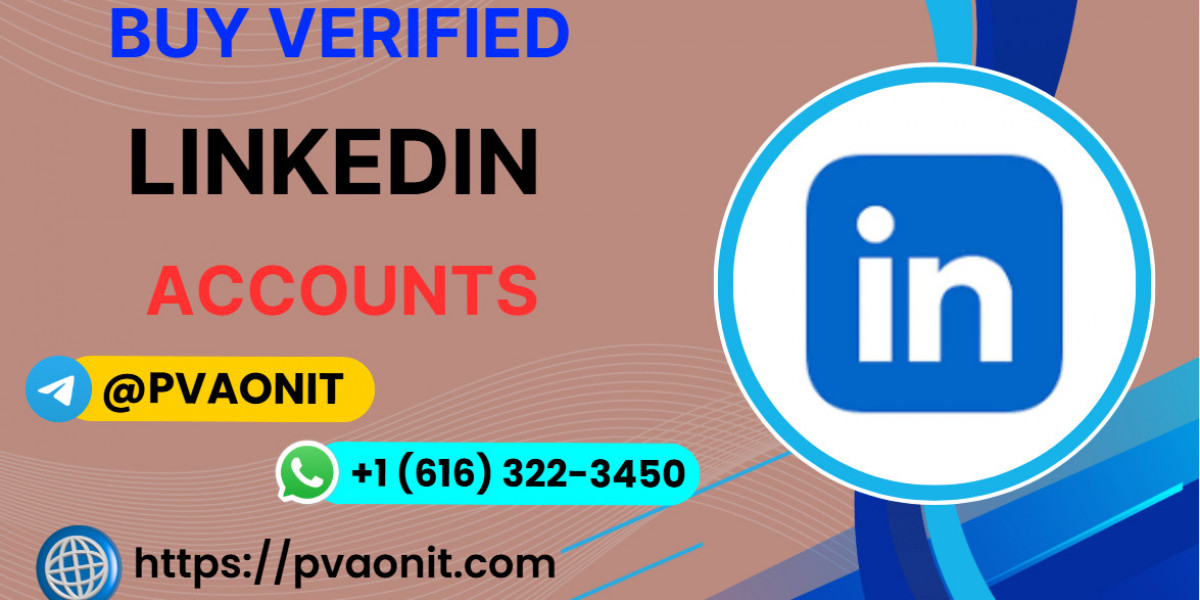Use These Tricks to Keep Your Bought Linkedin Account Safe: Expert Tips
You've just acquired a LinkedIn account, and you're eager to leverage it for networking and business growth. However, with great opportunities come potential risks.
----
?If you want to more information just knock us–
?Telegram: @pvaonit
?WhatsApp: +1 (616) 322–3450
---------------------------------------------
The last thing you want is to have your valuable account compromised. How can you ensure that your LinkedIn account remains secure? Don’t worry; we've got you covered with some essential tricks that will help you keep your account safe from threats.
By the time you finish reading this article, you'll feel more confident and in control, knowing exactly how to protect your digital asset. Let's dive into these smart strategies and bolster your LinkedIn security like never before.
Account Security Basics
Securing your purchased LinkedIn account is essential. The internet is vast and unpredictable. Protecting your account should be your first priority. Following basic security measures can help keep it safe. Let's explore some key steps to enhance your account security.
1. Use A Strong Password
Choose a password that's hard to guess. Mix letters, numbers, and symbols. Avoid using common words or sequences. Regularly update your password to maintain security. A strong password is your first line of defense.
2. Enable Two-factor Authentication
Two-factor authentication adds an extra layer of security. It requires a second verification step. This could be a text message or an app notification. It makes unauthorized access much harder. Activate it through your LinkedIn settings.
3. Monitor Account Activity
Regularly check your account activity. Look for unfamiliar logins or changes. LinkedIn provides a history of your sign-ins. If you see anything unusual, act quickly. Change your password and review your security settings.
4. Be Cautious With Third-party Apps
Third-party apps can access your LinkedIn data. Ensure they are trustworthy. Review permissions before granting access. Revoke permissions for apps you no longer use. This limits potential security risks.
5. Regularly Update Your Email
Keep your email address current. This ensures you receive security alerts. An outdated email can leave your account vulnerable. Update it in your LinkedIn profile settings. Stay informed about important account activities.
Password Management
Password management is crucial for safeguarding your LinkedIn account. A strong password acts as a solid defense against unauthorized access. It is essential to use unique and complex passwords to protect your online identity. Simple steps can significantly enhance your account's security.
Use A Strong, Unique Password
Create a password that combines letters, numbers, and symbols. Avoid using common words or easily guessable information. This complexity makes it difficult for hackers to crack your password.
Enable Two-factor Authentication
Two-factor authentication adds an extra layer of security. It requires a second form of verification, like a text message code. This makes it harder for unauthorized users to access your account.
Change Passwords Regularly
Regularly updating your password reduces the risk of unauthorized access. Set reminders to change your password every few months. This practice keeps your account safe from potential threats.
----
?If you want to more information just knock us–
?Telegram: @pvaonit
?WhatsApp: +1 (616) 322–3450
---------------------------------------------
Use A Password Manager
A password manager stores and manages your passwords securely. It generates strong passwords and remembers them for you. This tool simplifies managing multiple accounts efficiently.
Avoid Using The Same Password
Do not use the same password across multiple sites. Each account should have its own unique password. This limits the damage if one account gets compromised.
Two-factor Authentication
Securing your LinkedIn account is crucial in today's digital landscape. Two-factor authentication adds an extra layer of protection. It ensures that only you can access your account. This security feature requires two forms of verification. The first is your password. The second is a code sent to your phone. This makes it harder for hackers to breach your account.
What Is Two-factor Authentication?
Two-factor authentication (2FA) is a security measure. It requires two verification steps. First, enter your password. Next, enter a code sent to your device. This code changes with each login. It adds a dynamic level of security. Without both, access is denied. This minimizes unauthorized access.
Why Use Two-factor Authentication?
Two-factor authentication protects your LinkedIn account. It reduces the risk of hacking. Passwords can be stolen. Codes sent to your device are unique. They change each time you log in. This makes it difficult for hackers. Your account stays secure.
Setting Up Two-factor Authentication
Setting up 2FA is simple. Start by logging into LinkedIn. Navigate to your account settings. Find the security section. Choose two-factor authentication. Follow the on-screen instructions. You’ll need your phone. Enter your number. Verify it with the code sent to your device. Your account is now more secure.
Benefits Of Two-factor Authentication
Two-factor authentication offers peace of mind. It adds a layer of security. Protects against unauthorized access. Reduces the chance of hacking. Keeps your personal information safe. It’s an effective way to secure your LinkedIn account.
Recognizing Phishing Scams
In the digital age, safeguarding your LinkedIn account is crucial, especially if you've bought one to expand your professional network. Recognizing phishing scams is a vital skill you need to develop to protect your account from hackers. These scams are designed to trick you into giving away your personal information, and they can be surprisingly convincing.
How To Spot Suspicious Emails
Phishing emails often mimic legitimate companies, like LinkedIn, to deceive you. Always check the sender's email address for any oddities or spelling errors. If an email asks you to click on a link or provide personal details, pause and verify its authenticity.
Evaluating Links Before Clicking
Hover over links to see the actual URL before clicking. Does the link direct to a legitimate LinkedIn page or a suspicious site? If unsure, don't click. Instead, go to LinkedIn directly and check for any notifications or messages there.
Understanding Common Phishing Tactics
Phishers often create a sense of urgency, claiming your account will be suspended or you'll miss an important update. This fear tactic is designed to make you act quickly without thinking. Always take a moment to assess the situation calmly.
Real-life Example: A Close Call
Once, I received an email claiming to be from LinkedIn, asking me to verify my account. The email was convincing, but something felt off. Upon closer inspection, the URL was slightly different, and that saved me from a potential scam.
What To Do If You Suspect A Phishing Attempt
If you suspect a phishing attempt, report it immediately. LinkedIn has a support team that handles these reports. You can also warn your network to stay vigilant, helping others avoid the same trap.
Have you ever fallen for a phishing scam? How did you handle it? Sharing your experience could help others avoid similar pitfalls.
Device Security Measures
Safeguard your LinkedIn account by implementing robust security measures. Use strong passwords and enable two-factor authentication to protect your data. Regularly update your account settings to ensure optimal safety.
Keeping your LinkedIn account secure is crucial, especially if you've bought one to enhance your professional presence. Device security measures play a significant role in safeguarding your account from potential threats. They ensure that your access points to LinkedIn remain secure and trustworthy. Let’s dive into some practical steps you can take to protect your account through your devices. Outdated software can be a gateway for hackers. Keeping your device's software up-to-date is like locking your front door before you leave home. Updates often include security patches that protect against new threats. You might have experienced a device running slower when skipping updates. This not only affects performance but also increases security risks. Make it a habit to check for updates weekly.
Secure Wi-fi Connections
Imagine accessing your LinkedIn account using public Wi-Fi at a café. This can expose your data to malicious actors. Always ensure your Wi-Fi connection is secure. Use a VPN to encrypt your internet traffic, making it harder for others to intercept. At home, set a strong password for your Wi-Fi network. Avoid using obvious passwords like "123456" or "password." These are easy targets for hackers.
Use Strong Passwords
A strong password is your first line of defense. It should be complex, yet memorable to you. Combine letters, numbers, and symbols to create a robust password. Consider using a passphrase that is long and unique. Have you ever struggled to remember multiple passwords? Password managers can help store them securely. They simplify the process without compromising security. Two-factor authentication adds an extra layer of security. It requires you to verify your identity through another device or method. This makes unauthorized access much harder. Think about the times you’ve been asked to verify a login through a text message or app. This simple step can significantly boost your account's security.
Device Encryption
Encrypting your device protects the data stored on it. Even if someone gains access to your physical device, encryption keeps your information safe. Check your device settings to enable encryption. Consider situations where sensitive information is stored on your laptop or phone. Device encryption ensures it stays protected even if lost or stolen. By implementing these device security measures, you take proactive steps to safeguard your LinkedIn account. How do you prioritize security in your digital life? Share your thoughts and tips in the comments below!
Monitoring Account Activity
Safeguard your purchased LinkedIn account by regularly checking account activity. Enable notifications for suspicious logins and update passwords often. Monitor connections and messages to spot unusual behavior.
Keeping your LinkedIn account safe is essential, especially if you've purchased it for professional purposes. One effective way to ensure security is by monitoring your account activity regularly. This involves keeping an eye on how your account is used, identifying unusual patterns, and taking swift action when needed. Monitoring isn't just about security; it's also about understanding how your account is performing.
Check Login Locations
Always be aware of where your account is being accessed from. LinkedIn provides a feature that shows the locations of recent logins. If you notice a login from a place you've never been, this could be a red flag. Ensure that all login locations are familiar. If something looks suspicious, change your password immediately.
Review Devices
LinkedIn allows you to see a list of devices that have accessed your account. Regularly review this list to spot any unauthorized devices. If you see a device you don't recognize, it's crucial to remove access. This simple step can prevent potential misuse of your account.
Analyze Account Changes
Keep track of any changes made to your account information. This includes updates to your profile, contact details, or privacy settings. Regular checks can help you catch unauthorized modifications quickly. It's a proactive way to maintain control over your account's integrity.
Monitor Connection Requests
Be cautious with connection requests from unfamiliar profiles. Accepting requests from unknown individuals can expose your account to risks. Take time to review each request carefully. It's better to be selective and secure than to regret a hasty decision later.
Set Up Alerts
LinkedIn offers notification settings that alert you to various account activities. Customize these alerts to stay informed about logins, connection requests, and other key actions. These alerts act as an early warning system. They empower you to respond promptly to any suspicious activity. Monitoring account activity is not just about preventing unauthorized access. It’s about taking charge of your LinkedIn presence. How often do you check your account activity? Consider making it a part of your routine.
Privacy Settings Optimization
Optimizing your LinkedIn privacy settings is a crucial step in safeguarding your bought account. Without proper adjustments, sensitive information could be exposed, putting your professional reputation at risk. Let's explore how you can tailor your privacy settings to ensure maximum protection.
Review Your Profile Visibility
Determine who can view your profile. LinkedIn allows you to choose between public, connections only, or completely private. If you're not actively seeking new connections, consider limiting visibility to connections only. This simple tweak can significantly reduce unwanted attention.
Manage Connection Requests
Decide who can send you connection requests. You can restrict this to people who know your email address or are already connected to you. This helps keep your network tight-knit and trustworthy. Think about it: would you rather connect with a few trusted professionals or a crowd of strangers?
Control Activity Broadcasts
LinkedIn often shares updates about your activities with your network. If you're job hunting or making profile changes, you might not want everyone to know. Toggle the settings to stop broadcasting these updates to maintain privacy and control over what others see.
Limit Data Sharing With Third Parties
Review what data LinkedIn shares with third-party applications. You might be surprised at how much is shared by default. Adjust these settings to minimize data exposure. This simple act can shield your personal information from unintended access.
Adjust Ad Preferences
Ads can be tailored based on your LinkedIn activity. While personalized ads have their perks, they also mean sharing data. Opt out of ad personalization if safeguarding your data is more important than receiving tailored ads. How much data are you willing to share for a better ad experience?
Optimizing your privacy settings isn't just about clicking buttons. It's about making thoughtful choices that prioritize your security and peace of mind. Take control and make your LinkedIn experience safer and more tailored to your needs.
Secure Network Connection
Your LinkedIn account is a valuable asset. Securing it is crucial. One key aspect of security is your network connection. A secure network protects your data from hackers. It ensures your account remains safe from unauthorized access.
Use A Virtual Private Network (vpn)
VPNs encrypt your internet connection. They create a secure tunnel for your data. This makes it hard for hackers to intercept your information. Choose a trusted VPN service. It should have strong encryption protocols. Regularly update the VPN software for maximum security.
Avoid Public Wi-fi Networks
Public Wi-Fi is convenient but risky. Hackers can easily access your data on these networks. Use only secure, private networks for LinkedIn. If you must use public Wi-Fi, use a VPN. This adds an extra layer of security.
Enable Two-factor Authentication
Two-factor authentication adds security to your login process. It requires a second verification step. This can be a code sent to your phone. This makes it harder for anyone to access your account. Set it up via your LinkedIn settings.
Regularly Monitor Network Activity
Check your network activity regularly. Look for any unusual behavior. Strange logins or unknown devices should be investigated. This helps in spotting potential threats early. Take immediate action if anything seems out of place.
Keep Your Devices Updated
Regular updates are essential for device security. They fix known vulnerabilities. Install the latest updates for your operating system. Update your browser and security software too. This ensures your devices can fend off threats.
Regular Software Updates
Keeping your LinkedIn account safe is vital. One important step is regular software updates. These updates strengthen security and prevent unauthorized access. They fix vulnerabilities that hackers exploit. Regular updates ensure your software runs smoothly, which helps protect your account.
Why Are Software Updates Important?
Updates patch security holes. They make it harder for hackers to access your data. Updated software protects against new threats. It ensures you have the latest security features. These updates often include improvements and bug fixes.
How To Enable Automatic Updates
Turn on automatic updates in your settings. This ensures you never miss an update. It saves time and keeps your software current. Check your device settings for the automatic update option. Most systems offer this feature for convenience and safety.
Tips For Checking Updates Manually
Sometimes, updates need a manual check. Visit the software's official website for updates. Look for a 'check for updates' button in your software settings. Regular manual checks help when automatic updates fail.
The Impact Of Ignoring Updates
Ignoring updates leaves your account vulnerable. Hackers target outdated software. They exploit known security gaps. Skipping updates risks losing personal data. Regular updates are crucial for maintaining account safety.
Linking Trusted Email Accounts
Protect your purchased LinkedIn account by linking trusted email accounts. This adds an extra layer of security. Regularly update passwords for enhanced safety.
Linking trusted email accounts is crucial for safeguarding your LinkedIn account. This simple step adds an extra layer of security. It ensures you can recover your account if issues arise. Many users overlook this essential security measure. Let's explore how linking trusted email accounts can protect your LinkedIn profile.
Understanding The Importance Of Trusted Emails
Trusted email accounts help verify your identity on LinkedIn. They serve as a backup if you face login problems. This additional verification method strengthens account security. It reduces the risk of unauthorized access.
How To Add A Trusted Email
Start by visiting your LinkedIn settings. Select the 'Email Addresses' option. Add a secure and regularly checked email. Confirm the new email through the verification link. This ensures the email is correctly linked to your account.
Choosing The Right Email For Security
Pick an email you frequently monitor. Avoid using temporary or shared email addresses. This ensures you receive important LinkedIn notifications. Use an email provider known for strong security features. It adds another layer of protection to your account.
Regularly Update And Monitor Email Links
Regularly check the email addresses linked to your LinkedIn. Remove outdated or unused email accounts. This keeps your account information current and secure. Ensure your email provider maintains strong security protocols. This helps in guarding against hacking attempts.
Benefits Of Linking Multiple Trusted Emails
Linking multiple emails offers more security. It provides options if one email becomes inaccessible. It ensures continuous access to important LinkedIn updates. More backup options mean fewer worries about losing account access.
Using Trusted Third-party Apps
Keep your purchased LinkedIn account secure by using trusted third-party apps. These tools protect your data and ensure privacy. Always check app reviews and permissions before use.
When managing a purchased LinkedIn account, safety is crucial. Trusted third-party apps can enhance your account’s security and functionality. They offer tools to manage connections, schedule posts, and track engagement. But be cautious. Not all third-party apps are reliable. Choosing the right ones ensures your account remains secure and effective.
Understanding The Role Of Third-party Apps
Third-party apps provide extra features for LinkedIn. They can automate tasks, saving you time. Some apps help in analyzing your account's performance. This insight can improve your strategy. But, using unknown apps can risk your account's safety. Always check reviews before downloading an app.
Choosing Reliable Apps
Trustworthy apps come from reputable developers. Check the app’s ratings and reviews. Look for feedback from other LinkedIn users. This helps in judging the app’s reliability. Avoid apps with many negative reviews or complaints. They might compromise your account's security.
Reading Terms And Conditions
Before using an app, read its terms and conditions. This document explains how the app uses your data. Ensure the app doesn’t misuse your information. Some apps might share your data with third parties. This can lead to security issues. Be informed about what you agree to.
Regularly Updating Apps
Keep your apps updated. Developers release updates to fix security flaws. An outdated app can be a security risk. Regular updates ensure you have the latest features. They also protect your data from potential breaches. Set apps to update automatically if possible.
Monitoring App Permissions
Check the permissions apps request. Some apps ask for unnecessary access. This can be a red flag. Limit access to only necessary information. Review permissions regularly to ensure safety. If an app changes permissions, reassess its use.
Avoiding Public Wi-fi Risks
Public Wi-Fi is convenient. But it poses security risks to your LinkedIn account. Hackers often target these networks to steal information. Protect your account by avoiding public Wi-Fi whenever possible. This section offers practical advice to safeguard your LinkedIn account.
Understanding The Risks Of Public Wi-fi
Public Wi-Fi is widely available. But it lacks strong security measures. Hackers use these networks to intercept data. Your LinkedIn account can be vulnerable. Avoid using public Wi-Fi for sensitive tasks.
Always Use A Vpn
A Virtual Private Network (VPN) encrypts your internet connection. It hides your data from prying eyes. VPNs protect your LinkedIn account on public Wi-Fi. Choose a reliable VPN service for maximum security.
Disable Auto-connect Features
Devices often connect to available Wi-Fi automatically. This feature can expose your data. Disable auto-connect features in your settings. This helps control where your device connects.
Update Security Settings Regularly
Check your device's security settings often. Enable firewalls and antivirus software. Regular updates strengthen your defenses. Secure settings keep your LinkedIn account safe.
Use Two-factor Authentication
Two-factor authentication adds a layer of security. It requires a second verification step. Even if someone gets your password, they need another code. Enable this feature on LinkedIn for added protection.
Understanding Account Recovery
Understanding account recovery is vital for keeping your LinkedIn account safe. It helps you regain access if your account gets compromised. Knowing the recovery process can protect your professional network. This ensures that your connections and valuable data remain secure.
Understanding The Recovery Process
The recovery process begins with verifying your identity. LinkedIn might ask for your email or phone number. This step confirms you are the legitimate account owner. Having your details updated ensures a smooth recovery.
Setting Up Security Questions
Security questions add an extra layer of protection. Choose questions only you can answer. This can prevent unauthorized access to your account. Always keep these answers private and memorable.
Using Two-factor Authentication
Two-factor authentication strengthens your account security. It requires a code sent to your phone. This step makes it harder for hackers to access your account. Always enable this feature for added safety.
Regularly Updating Your Recovery Information
Keep your recovery information current. Update your email and phone number regularly. This ensures you can quickly recover your account. It also helps LinkedIn contact you for any security alerts.
Keeping Backup Codes Secure
Backup codes are crucial for account recovery. Store these codes in a safe place. They are your lifeline if you lose access to your phone. Use them wisely and sparingly.
Reporting Suspicious Activity
Keeping your LinkedIn account secure is crucial in today's digital age. Reporting suspicious activity is a vital step. It helps protect your account from potential threats. Vigilance can save your account from hackers and scammers. Learn how to spot and report unusual behavior on LinkedIn.
How To Spot Suspicious Activity
Be alert to unusual login locations. Watch for unknown devices accessing your account. Pay attention to sudden changes in your connections. Notice unexpected messages from strangers. These signs may indicate something wrong.
Steps To Report Suspicious Activity
Locate the suspicious activity section in LinkedIn's settings. Click on 'Help' and select 'Safety Center'. Follow the prompts to report issues. Provide detailed information about the suspicious activity. This helps LinkedIn investigate effectively.
Why Reporting Is Important
Reporting helps LinkedIn track security threats. It contributes to a safer community for all users. Your report can prevent others from falling victim. It strengthens LinkedIn's ability to protect accounts. Your vigilance benefits everyone using the platform.
Tips For Keeping Your Account Safe
Use strong passwords and change them regularly. Enable two-step verification for added security. Regularly review your account activity. Stay informed about common online scams. Educate yourself on best practices for online safety.
Avoiding Over-sharing Information
In the age of digital networking, maintaining privacy on LinkedIn is crucial. Sharing too much information can expose you to various risks. Keep your LinkedIn account safe by being mindful of the details you disclose. Protecting your personal and professional data should be a priority. Let’s delve into some effective strategies.
Minimize Personal Details
Keep your personal life separate from your LinkedIn profile. Avoid sharing your home address or phone number. These details are not necessary for networking. Focus on professional information only.
Limit Work History Information
Share only relevant work experiences. Too much detail may help competitors. Be concise about your roles and achievements. A brief overview is often enough.
Restrict Contact Information
Set your contact information to private. Only share your email with trusted connections. This reduces unwanted messages and potential scams.
Avoid Sharing Future Plans
Keep future projects and career moves private. Sharing plans can invite unwanted attention. Discuss these details only with close connections.
Control Who Sees Your Updates
Adjust your privacy settings. Decide who can see your posts and updates. Only share them with connections you trust.
By following these tips, you can maintain a secure presence on LinkedIn. This ensures that your professional life remains private and protected.
Managing Contact Lists
Safeguard your purchased LinkedIn account with simple tactics. Regularly update passwords and verify connected apps for security. Manage contact lists wisely to prevent unauthorized access and ensure privacy.
Managing your contact list on LinkedIn is more than just a routine task—it's a critical step in safeguarding your account and maintaining a professional network. Whether you've bought a LinkedIn account or grown it organically, keeping your contacts organized and secure is essential. Let's dive into some practical tips to help you manage your contact list effectively and ensure your LinkedIn account remains safe.
Prioritize Quality Over Quantity
Growing your network isn't just about numbers; it's about meaningful connections. Focus on adding contacts who are relevant to your industry or career goals. A smaller, well-curated list is often more beneficial than a large, unvetted one. Ask yourself, does this contact add value to your network? Prioritizing quality ensures your feed remains relevant and engaging.
Regularly Review And Update Contacts
Keeping your contact list fresh is crucial. Schedule time monthly to review and update your connections. Remove contacts who are no longer relevant or inactive. This practice not only keeps your network clean but also reduces the risk of outdated or incorrect information circulating.
Utilize Linkedin’s Privacy Settings
LinkedIn offers robust privacy settings to help manage your contact list. Take advantage of these settings to control who sees your connections. Customize your visibility to protect sensitive information and avoid unwanted contact requests. This step is vital in maintaining both your privacy and professional integrity.
Engage With Your Contacts
Actively engaging with your contacts strengthens relationships. Like, comment, and share content from your network to stay connected. Engagement keeps you on their radar and builds rapport, which is invaluable if you ever need assistance or collaboration. When was the last time you interacted with your connections?
Be Cautious With Connection Requests
Not all connection requests are genuine. Be vigilant and scrutinize each request before accepting. Check profiles for authenticity—look for complete profiles, mutual connections, and relevant industry experience. Protecting your network starts with being selective about who you let in. Incorporating these strategies into your LinkedIn routine will help you maintain a secure and professional network. Remember, a well-managed contact list isn't just about who you know—it's about how those connections can help you achieve your professional goals.
Regular Password Changes
Regularly updating your password is vital to keep your bought LinkedIn account safe. This simple habit makes unauthorized access harder, protecting your data from hackers. Choose complex passwords and change them often to enhance security.
Keeping your LinkedIn account secure is crucial, especially if you've purchased a premium account. One effective way to enhance your account's safety is through regular password changes. This simple yet powerful strategy can prevent unauthorized access and protect your personal data. It's easy to overlook this practice, but maintaining a habit of updating your passwords can make a significant difference in your online security. Let's dive into why this matters and how you can implement it seamlessly.
Why Regular Password Changes Matter
Passwords are the first line of defense for your LinkedIn account. Over time, they can become compromised due to data breaches or phishing attacks. By regularly changing your password, you reduce the risk of unauthorized access to your account. Consider your password like the lock on your front door. Would you keep the same lock forever, knowing its security could weaken over time? Regular updates ensure that your "lock" stays strong and resistant to potential threats.
How Often Should You Change Your Password?
Changing your password every three to six months is a good practice. This frequency balances security without becoming too burdensome. However, if you suspect any unusual activity on your account, don't hesitate to update your password immediately. Listening to your instincts can often prevent potential security breaches.
Choosing A Strong Password
When creating a new password, ensure it's strong and unique. Use a mix of uppercase and lowercase letters, numbers, and special characters. Avoid using easily guessed passwords like "password123" or your birthdate. Strong passwords are harder for hackers to crack, keeping your account more secure.
Using Password Managers
Consider using a password manager to keep track of your passwords. These tools can generate strong passwords for you and store them securely. This way, you don't have to remember complex passwords and can easily manage regular updates. Password managers provide convenience without compromising security.
Engage With Your Security Settings
Regularly review your LinkedIn security settings. Make sure to enable two-step verification for an extra layer of security. Engaging with these settings ensures you stay informed about any new security features or changes that can help keep your account safe. Being proactive with your security settings can make all the difference. In what ways have you ensured your LinkedIn account stays secure? Remember, taking small steps like regularly changing your password can significantly enhance your online safety.
Recognizing Fake Profiles
Fake LinkedIn profiles can harm your online reputation. Spotting them is crucial. They can appear genuine at first glance. But there are tell-tale signs. Knowing these signs helps protect your account.
This section will guide you. Learn to identify fake profiles. Keep your LinkedIn account safe from threats.
Unusual Profile Photos
Fake profiles often use generic photos. They might seem too perfect. Or they might lack personal touch. Always check the photo closely.
Perform a reverse image search. This can reveal if the image is used elsewhere. Genuine profiles usually have unique pictures.
Incomplete Profile Information
Real profiles have detailed information. Fake ones often lack details. Check the profile for job history. Look for education details. Gaps in information are a red flag.
Compare the information with other profiles. Consistency is key. Inconsistent details suggest the profile might be fake.
Poorly Written Content
Authentic profiles have well-written content. Fake profiles may have spelling errors. Or they might use awkward language.
Read the profile summary carefully. Look for clarity and coherence. Errors and awkwardness often indicate a fake profile.
Connections And Endorsements
Genuine profiles have meaningful connections. Fake profiles may have random connections. Check for endorsements too.
Real profiles receive endorsements from colleagues. Fake profiles might lack genuine endorsements. This can reveal their authenticity.
Securing Mobile Access
Protect your LinkedIn account by setting strong passwords. Enable two-factor authentication for an extra layer of security. Regularly monitor account activity to spot any suspicious behavior.
Securing mobile access to your LinkedIn account is crucial. Mobile devices are often vulnerable to security threats. Many users access LinkedIn via smartphones. Thus, ensuring safety on these devices is essential. This section covers effective methods to protect your LinkedIn account on mobile devices.
Enable Two-factor Authentication
Two-factor authentication adds an extra layer of security. It requires a second form of verification. This might be a code sent to your phone. Even if someone knows your password, they can't access your account without this code. It significantly reduces unauthorized access risks.
Use A Strong, Unique Password
Choose a strong password for your LinkedIn account. Avoid using common words or easily guessed phrases. Combine letters, numbers, and symbols. Make sure your LinkedIn password is unique. Do not reuse passwords from other accounts. This prevents hackers from accessing multiple accounts if one is compromised.
Regularly Update Your Linkedin App
Keep your LinkedIn app updated. Developers fix security vulnerabilities with each update. Using the latest version ensures you have the latest security features. It also improves app performance and user experience. Set your app to update automatically if possible.
Be Cautious With Public Wi-fi
Public Wi-Fi networks pose security risks. They are often unencrypted and easily accessible by hackers. Avoid logging into your LinkedIn account on public networks. If necessary, use a virtual private network (VPN) for a secure connection. VPNs encrypt your data, providing added security.
Enable Device Lock Features
Activate device lock features on your smartphone. Use a PIN, password, or biometric lock. This adds a layer of security in case your device is lost or stolen. Ensure your lock screen settings are enabled and strong. It prevents unauthorized access to your LinkedIn account and other sensitive apps.
Utilizing Security Alerts
LinkedIn is a powerful tool for networking and professional growth, but keeping your bought LinkedIn account safe is crucial to protect your personal and professional information. One effective way to enhance your account security is by utilizing security alerts. These alerts keep you informed about suspicious activities, helping you take immediate action if necessary.
Understanding Security Alerts
Security alerts are notifications sent to you when unusual activity is detected on your account. They act like your digital watchdog, ensuring you stay informed. Imagine getting a notification about a login attempt from an unfamiliar location; would you ignore it or check it immediately?
Setting Up Alerts
To set up security alerts, navigate to your LinkedIn settings. Look for the security section and activate alerts for logins and suspicious activities. This small step can make a big difference in keeping your account safe.
Reacting To Alerts
Receiving an alert is the first step; your reaction is the next critical phase. If you get notified about a login from a foreign location, change your password immediately. Always be proactive rather than reactive.
Personal Experience With Security Alerts
Once, I received a security alert about a login attempt in a country I had never visited. Thanks to the alert, I was able to change my password and secure my account. Has a security alert ever saved you from potential threats?
Benefits Of Regularly Monitoring Alerts
By regularly monitoring your security alerts, you create a habit of vigilance. This not only keeps your account safe but also boosts your confidence in managing your digital presence. Are you willing to make security monitoring a regular part of your LinkedIn routine?
Utilizing security alerts is a straightforward yet powerful way to protect your LinkedIn account. Take action today to ensure your account remains secure and your professional information stays private.
Conclusion
Keeping your LinkedIn account secure is important. Your professional identity matters. Follow these tricks to ensure safety. Change your password often. Use two-factor authentication. Be cautious with third-party apps. Monitor your account activity regularly. Report suspicious messages and profiles. Stay informed about LinkedIn updates.
Protect your online presence with smart practices. Your efforts will keep threats at bay. A safe account means peace of mind. Don’t let security slip through the cracks. Take steps today to guard your LinkedIn account. Your career deserves the best protection.
Stay safe, stay smart, and enjoy networking securely.








